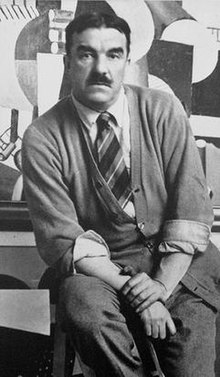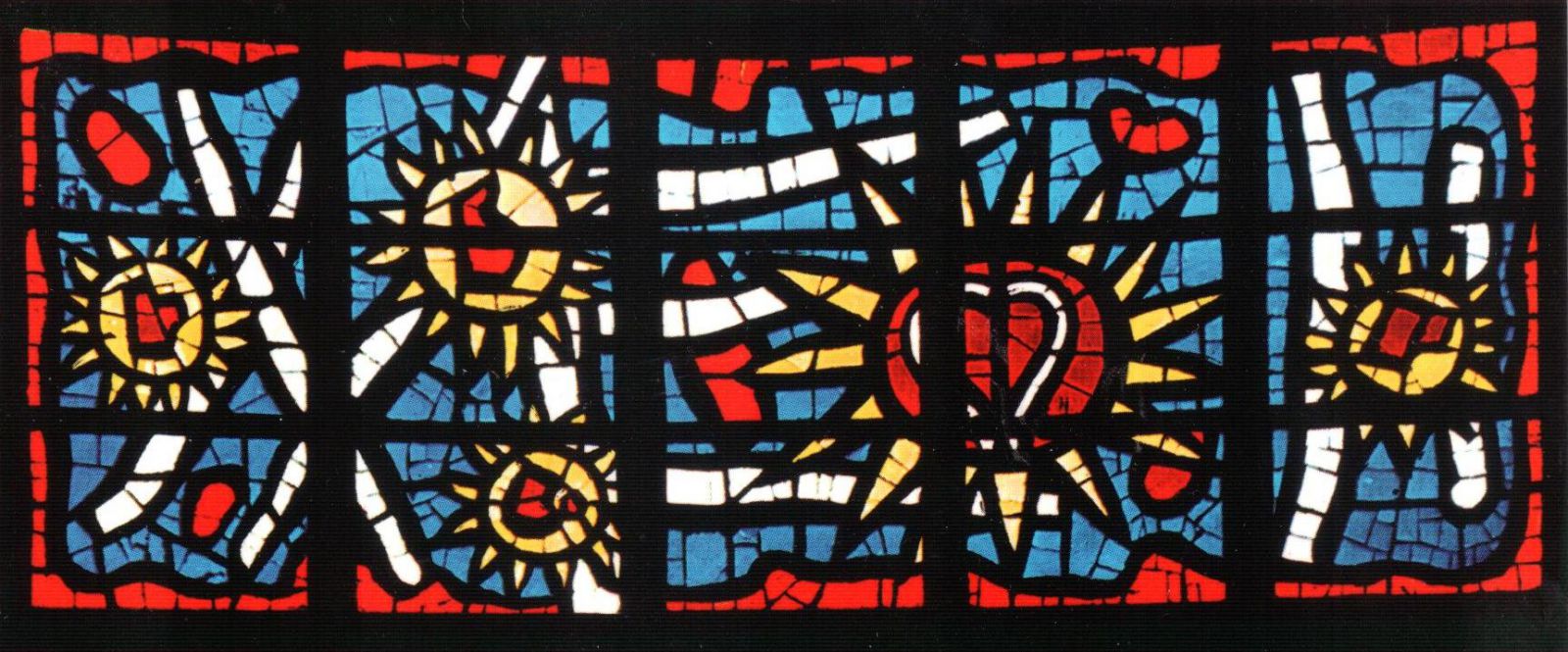再見 Fernand Léger (勒澤,1881~1955) Fernand Léger, the Sacré-Coeur in Audincourt, 餘。餘音,餘情,餘地。餘興,餘墨,餘事。蘇軾不悅於頤。儀,余儀10月31日今昔 1031 2021、
Have a great weekend with Fernand Léger!  A painter of the city and a privileged witness to the changes of his time, Fernand Léger is one of the most famous figures in the adventure of modernity! From the cubist avant-garde to the communist commitment, his painting remains associated with his great standardised icons, a vision of humanity transfigured by the machine and mass production.Discover more of the artist's work
A painter of the city and a privileged witness to the changes of his time, Fernand Léger is one of the most famous figures in the adventure of modernity! From the cubist avant-garde to the communist commitment, his painting remains associated with his great standardised icons, a vision of humanity transfigured by the machine and mass production.Discover more of the artist's work  https://bit.ly/CP_Léger
https://bit.ly/CP_Léger
11.4.2021
Hanching Chung
Fernand Léger (1881~1955 ):建築、藝術與他;眾生參訪1937年巴黎万国博覧会。論紀念性與色彩 On Monumentality and Color 約1943~1953? 天主教堂藝品奉獻 France: The Sacré-Coeur, Audincourt 1951。家庭開車鄉間遊Country Outing
2021.11.04
https://www.facebook.com/hanching.chung/videos/611084200037280
---
221.11.14
再見 Fernand Léger (勒澤,1881~1955)
https://www.facebook.com/hanching.chung/videos/217899043748739
Fernand Léger | |
|---|---|
 Fernand Léger, c. 1916 | |
| Born | February 4, 1881 |
| Died | August 17, 1955 (aged 74) Gif-sur-Yvette, France |
| Nationality | French |
| Known for | Painting, printmaking and filmmaking |
| Movement | Cubism Modernism |
建築與他
****
餘。餘音,餘情,餘地。餘興,餘墨,餘事。蘇軾不悅於頤。儀,余儀、
https://www.facebook.com/hanching.chung/videos/268316455303556
https://www.artway.eu/content.php?id=796&lang=en&action=show
France: The Sacré-Coeur, Audincourt
The Sacré-Coeur in Audincourt, France
The Power of Red, Yellow and Blue
by Albert Hengelaar
In the 1930’s the French Dominican friar and Catholic priest Marie-Alain Couturier was enabled by his order to devote himself to new art in the Catholic church. The enthusiastic clergyman was annoyed at the superficial art and church architecture of the 19th and 20th centuries. He looked back with longing to the élan of the time of the great cathedrals. His approach was to summon well-known artists and architects to participate in the building of new churches and to also involve the local community.
An artist once replied to Couturier: ‘Do you not know that I am Jewish?’ Couturier answered: ‘If you don’t mind, I certainly don’t.’ He believed that competent artists whatever their beliefs could express Christian stories of faith as ‘they have not resounded anymore for 500 years.’
Perhaps it is not ideal when those of different beliefs receive commissions for art in the church, yet the results of their labour show time and again that this is a worthy option, especially when artists of faith do not want to work under the authority of the church anymore or simply do not know how to go about doing this in a way that is contemporary. In the same way, Solomon had involved artisans from a foreign country in the building of the temple (2 Chronicles 2).
As a product of this fruitful Art Sacré movement we want to introduce you to the Sacré-Coeur in Audincourt, in the north east of France, that was built in 1949-1951. At first sight it seems just a simple complex, but because of this the well-considered and balanced artistic execution speaks all the more powerfully. This already starts when you stand facing the church on the church square. On the facade the large mosaic by Bazaine with its water and fishes pulls you towards the church. The artist suggests: ‘It possesses a joyful and powerful appeal like a river in summer. One should not stay to meditate in front of a church, but one should feel like diving in.’
Also the interior structure of this church designed by architect Novarina is straightforward and simple, so that all attention can be focused on the message that is communicated in this space in word and image. The floor with its wave motif continues the theme of water. The 17 stain-glass windows by Fernand Léger, running along the upper side of the three walls, resemble a crown. They depict various aspects of the meaning and life of Christ. Behind the altar hangs a tapestry by Léger with grain, grapes and fishes. It meaningfully combines with the three windows depicting Christ’s crucifixion right above it, with the five wounds of Christ shining like five suns in the centre.
The serene and intimate atmosphere of the crypt stands in stark contrast with the euphoria of the baptismal chapel close to the entrance of the church. The walls of this round chapel are completely covered with stain-glass windows by Bazaine, so that the visitor is immersed in a feast of movement and light. Here Bazaine continues the theme of the water used on the façade, inspired by the text from Ecclesiasticus (or Wisdom of Jesus Sirach) that runs along the bottom of the windows: ‘Aujourd’hui mon fleuve est devenu mer. Au matin je ferai luire la Parole’ (And, lo, my river became a sea. I will yet make doctrine to shine as the morning, KJV). The baptismal font is sculptured out of lava by Etienne Martin; the rim along its upper part enfolds the baptismal font in a protecting embrace.
And so it happened that an inconspicuous industrial town like Audincourt acquired a church that is advertised on big signs along the motorway as a special feature of the area. This is to be expected when a cleric attracts artists like Léger and Bazaine to ecclesiastical art. When we were visiting men were busy installing underfloor heating: a sign that the original goal of its erection is still being done justice, namely offering a place of worship to local believers. When you decide to see the church for yourself, combine it with visiting the magnificent Notre-Dame-Du-Haut in nearby Ronchamp. Evidently also a church that cannot be thought of without the vision of Marie-Alain Couturier.
*******
For more information about Couturier and the artists and churches influenced by the Art Sacré movement, click here. To read about another well-known church of the Art Sacré movement, Notre-Dame de Toute Grâce (Our Lady of All Grace), Plateau d’Assy in France, click here.
Albert Hengelaar is involved in establishing a presence for the World Evangelical Alliance at the United Nations in Geneva. He is married to ArtWay’s Editor-in-Chief, Marleen Hengelaar-Rookmaaker.
ArtWay Visual Meditation July 24, 2016
高野 長英----Prayers for the Pandemic: 1,300 Years of Ritual at Todaiji
(文化1.5.5—嘉永3.10.30∕1804.6.12—1850.12.3)
日本江戶時代末期的醫生與蘭學(以荷蘭文為語言工具的西方文化與科學)學者。曾向駐日的西博爾德醫師學習醫學與蘭學。於1832年完成日本第一本生理學著作《醫原樞要》,並翻譯了多部荷蘭書籍。
蘭學傳入我國尚不至兩百年,然從習蘭學者,於千人之中尚且未及一、二人。輕蔑者眾而尊信者少。吾人不顧貶抑而從習蘭學,乃因其言之有理,且與民有利。否則何以捨我福祥神國,甘赴凍寒不毛之西洋之地,從習西夷乎?……天賜之蘭學,何以受此災厄?哀哉!蓋以蘭學為志業而死於蘭學,同於致於忠義之事而死於忠義之事,於理無憾,於義亦無所恥也。
節自〈鳥啼〉
NHK World 奈良東大寺2周千年前求觀音驅ˊ無瘟疫之作法、儀式
PRAYERS FOR THE PANDEMICS


沒有留言:
張貼留言